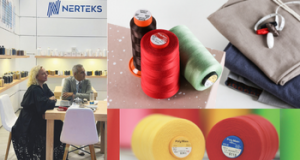With a rich heritage established in the 1750s, Coats is the world’s leading industrial thread and textile crafts business, at home in more than 70 countries, employing 20,000 people
across six continents.
Coats Insectiban threads and zips are treated with an anti-bed bug chemical that protects against infestations. Coats Insectiban products prevent the spread of bed bugs in seams and joins of mattresses, upholstered furniture, luggage and bedding where the pests like to reside and lay their eggs. The chemical treatment used in Coats
Insectiban products is based on naturally occurring, durable plant extracts and oils and is harmless to humans and pets. However, it is fatal to bed bugs after extended exposure
– approx. 4 days. Coats Insectiban has been tested and validated for insecticidal efficacy by Laboratoire T.E.C based in France Bed bugs (Cimex lectularius and Cimex hemipterus) are reddish brown insects that grow to about 7mm in length and have a wide, flat body shape. They feed on human blood, injecting an anticoagulant saliva and then feeding for up to 15 minutes. A bite is painless, but the saliva causes irritation and inflammation. Bed bugs don’t carry any diseases but secondary infection from scratching the bites can occur. Adult bed bugs can take up to a month to develop from eggs, and can live up to 18 months.
Bed bugs are flightless but can be transported by humans from an infested location. The seams and tape edges of household beds, sofas and other furniture can harbour bed bugs. They, nymphs or eggs can all be transported by humans from an infested location. High transit locations, such as hotels, hostels and care homes are common exchange sites for infestations. People may bring the bugs in with their luggage or clothing and others will take them out. If the density of bugs is high enough infestations can spread within buildings e.g. between flats, rooms.
Signs of infestation
* Often people only realise they have an infestation once they are bitten
* The small bites, which are often clustered together, are generally painless but cause itchiness which depends on the individuals sensitivity
* Generally bed bugs are nocturnal and bite when someone is asleep
* If the infestation is on furniture they will bite at other times
* Between feeds, bedbugs hide in dark protected sites and they prefer textiles, paper or wood. Other tell tale signs of infestation include:
* Physical presence – bed bugs can often be seen on bedding or furniture, as can the blood stains they leave if they are crushed after feeding
* Eggs – these are white, oval and about 0.8mm long. They will normally be in crevices, for example seams, as they attach their eggs into the same place they use as lairs.
* Moulted skins – as bed bug nymphs develop they shed their skins and these can sometimes be found on mattresses and furniture.
* Smell – bed bugs emit a musty sweet smell that is detectable by humans in heavy infestations. Dogs are sometimes trained to detect infestations by smell. Bed bug infestations can be difficult to deal with. Some approaches can include:
* DDT based insecticides were historically used infestations, but with the banning of these insecticides bed bugs have been on the increase again
* Eradication can require fumigation with pyrethrine based insecticides, which are also banned for use in many locations. Such insecticides can not be used on mattresses
* Changing all soft furnishings and clothing along with a deep clean can
be effective, but is a high cost solution.
* Encapsulation covers for mattresses have been used to trap bedbugs in an infected mattress so that they cannot bite the mattress user. They can also be used to prevent bugs from infecting a clean mattress. Benefits of Coats Insectiban
* Bed bug infestations are on the rise as an increasingly mobile population transports these parasites to and from high transit locations such as hotels, hostels and domestic homes
* As bed bugs use the seams and tape edges of mattresses and other furniture as a location to hide and to lay their eggs, a treated sewing thread and/or zip will help to control an infestation even if the fabric and other elements of the bedding have not been treated
* Where the other components of the mattress have been treated, then using treated thread and zips is essential to ensure that the favoured locations for bed bugs (i.e. seams and joins) provide a higher degree of protection.
* Coats Insectiban provides a real solution to a significantly growing problem. Coats Insectiban Product range
* Any thread (irrespective of substrate, size or colour) and zip can be treated with the Coats Insectiban technology
* No effect on sewing performance or chemical and physical properties
* Colour fastness properties are in line with Coats high levels for existing threads
* Depending on the application, the following threads examples could be used:
– Epic 30/40/50
– Dual duty 25/36/50
– Nylbond 40
– Gral quilting 40/60/80
* In the case of zips used in mattresses and in furniture, Opti S60 Insectiban is recommended
* Different formulations of Insectiban are required for North America due to the different type of bed bugs and we are in the process of developing a product for the US market during 2013 The well-known brands of Coats and strong relationships with its customers and consumers mean their products and services meet current and future needs. Their company-wide understanding of their business partners and consumers, coupled with the deep expertise of people, builds trust and certainty
 SleepTech Magazine Mattress, Accessories, Machinery, Raw Materials
SleepTech Magazine Mattress, Accessories, Machinery, Raw Materials


